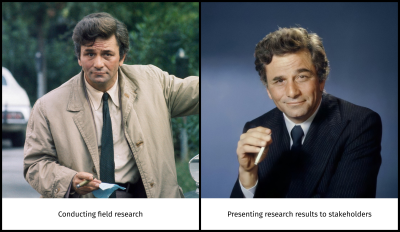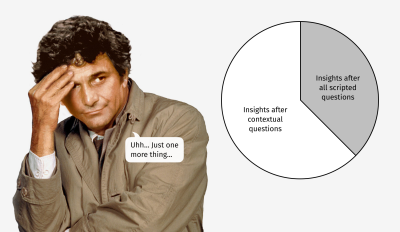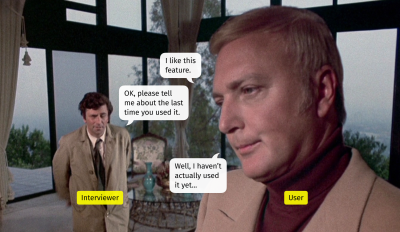If you don’t know Lieutenant Columbo, I envy you. I wish I could erase my memory and watch this TV masterpiece for the first time again. Columbo, a Los Angeles homicide detective, has become a cult character in American crime drama in the 1970s. Each episode of this show reveals the murderer from the first minute, and the main mystery is how Columbo proves their guilt and distinguishes between lies and the truth.
When I reflect back on this series, it becomes apparent that the UX area has so much in common with crime scene investigation: the truth is unknown, people tend to disguise their real needs, and you have to discover missing facts as soon as possible to build and launch something useful. I’ve never specialized in UX research, but it has been part of my job as a designer for years. When I started, we rarely had the luxury of a dedicated researcher on a team.
So, let’s see what we can learn from a classical fictional character and apply it in the UX area.
Lesson 1: Understate Your Role To Users
Contents
It’s not a secret that people behave differently in the vicinity of police, state officials, or management. Columbo understood that if a suspect or witness realized who he was, they would try to disguise or tweak facts (either consciously or subconsciously). That’s why our hero preferred to blend in and keep his position out of sight as long as possible.

For instance, in the episode “By Dawn’s Early Light” (S4E3), the commandant of a military academy murders the chairman of the board. So, Columbo stayed in the barracks for several days and talked with cadets informally until he exposed the killer.
Sometimes, such an approach has caused funny situations. In the episode “Negative Reaction” (S4E2), Columbo was mistaken for a hobo at St. Matthew’s Mission. Lieutenant patiently accepted the nun’s caring and ate a bowl of stew, and only when she suggested a new raincoat instead of Columbo’s beloved old one, he revealed his purpose.
UX research is no less challenging because we explore human behavior but inevitably influence the findings since we are humans, too. Designers often run the risk of receiving twisted information when they forget to tackle users’ fears and insecurity, for example:
- Interviewees believe their boss sent you to assess their skills;
- Users think you created this design, and now they try not to offend you;
- Customers worry that you’ll judge their computer literacy.
Understating your official role gives you precious moments to talk with people more sincerely. In contrast, here is a perfect intro to annihilate research accuracy: “Hello! I’m a Senior UX Designer and Product Manager. Today, I’ll conduct a usability testing session and jobs-to-be-done interview to identify UX gaps in our design…” After hearing that, people would probably flood you with socially expected answers.
Instead, designers should keep their fancy titles to themselves. Try to start a usability testing session humbly, “My name is <…>, and I was asked to check whether this website is useful and clear to you.” Don’t make people think you designed it (even if you did).
And here is an intro phrase I recommend using for a user interview, “I’m a researcher, and today I’d like to ask you a couple of questions about <…>.” Give a simple description without redundant details that may scare people and increase tension.
Depending on the situation, you can even say, “I didn’t design this, so I won’t be offended if you criticize it; please be honest with your feedback!” But it’s on the thin edge between ensuring less biased research and lying.

Lesson 2: “You Don’t Know My Boss…”
Lieutenant Columbo usually dealt with wealthy and mighty criminals who were sure they would go unpunished. So, he played the role of a “little man” and wasn’t ashamed of it. He realized that exposing his authority would only make people stay within their own shells. Not only did he hide his intellect, but he also encouraged others to feel superior towards him so that people behaved more freely and revealed their true motives.

Columbo looked messy — in a creased beige raincoat, with a cigar, driving an old Peugeot — and concealed his shrewd mind behind this slack appearance and sloppy communication manner. He often told naive stories about his wife and appeared henpecked:
Columbo: I’m a worrier. I mean, little insignificant details, I lose my appetite, I can’t eat. My wife, she says to me, “You know, you can really be a pain.”
Another quote is about the “strict” boss, although it’s apparent from the series that the Lieutenant was a self-organized expert:
Columbo: You’re a celebrity. Because of you, my boss, he won’t let me close up this case until I have covered everything. Every loose end gotta be tied up.
As a newbie designer, I was indoctrinated about the value of presentation skills, making a positive first impression, and the necessity of defending design decisions. However, later, these conventions played a cruel joke on me.
In UX research, a common misconception is that you should look confident and competent in front of users. Let me get this straight: conducting research is not the same as presenting designs to top management. During any research, the goal is to make people feel relaxed so that they tell you the truth. However, at a presentation, the main task is to assure everyone that your decision is well-informed and your input helps steer the business in the right direction.
Research is not meant to show off. You see a user for the first and probably the last time in your life; they won’t influence your career; they aren’t here to be impressed. Behave humbly while staying in control of the session. Yes, you may come across as an ordinary person, but it’ll pay off and bring more insights compared to “boss-subordinate” or “expert-noob” paradigms. I’m not saying one should literally look messy like Columbo. The idea is to blend in, for instance:
- Match interviewees’ dress code (within reason, of course).
Try not to appear much more official or extravagant than a person in front of you, and you’d better keep that creative “Helvetica” T-shirt and “You ≠ user” pin for a UX meetup. - Avoid design jargon or terminology you have to explain.
However, a reasonable dose of your interviewees’ professional lingo will boost communication if you work on a specialized topic. - Behave neutrally but naturally.
It means balancing impartiality and separation from the subject with normal human behavior and empathy (simply saying, not being a robot).
We call this approach “user safari” nowadays, but Lieutenant Columbo had been practicing it long before it became designers’ mainstream. If you want to understand your suspects (in our case, users), observe their behavior in a “natural habitat,” and don’t miss a chance to try users’ occupations. It’s better to see once than to hear a thousand times, right?

For example, in the episode “Any Old Port in a Storm” (S3E2), a wine connoisseur kills his brother to prevent him from selling the family winery. Columbo had to turn into a sommelier enthusiast for a while to investigate this crime and recognize unusual evidence, which would have been overlooked without specialized knowledge.
The episode “Negative Reaction” (S4E2) features a talented photographer and Pulitzer Prize winner who kills his wife and blames her death on a failed kidnapping. Columbo gets a camera and learns the basic principles of photography to convict the criminal. The detective had absolutely no proof, but owing to the newly gained knowledge, he set a cunning trap so that the murderer gave himself away.
Now, UX research. Of course, we shouldn’t literally follow the TV series and get expensive equipment just to step into users’ shoes. Fortunately, one can empathize much more easily nowadays. I mean observation studies and contextual inquiries when you can access users or documentaries, YouTube blogs, and professional communities if you want to prepare to face real users and avoid surface-level questions.
For example, several years ago, I was preparing for interviews with drilling engineers — future users of a new app suite for drilling planning. So, I watched “Deepwater Horizon,” a U.S. movie about a historical oil spill disaster in the Gulf of Mexico. This movie was recommended by a subject matter expert from the client’s side; he told me it realistically showed a drilling rig in action. As a result, I understood the technical jargon and used interviews with engineers to figure out really unobvious facts, not Wikipedia-level basics.
Another vivid example is a project I heard about from my former colleagues, who conducted product discovery for a Middle East logistics company several years ago. So, during an on-site, the discovery team observed the actual work of delivery crews and eventually witnessed a problem that couriers didn’t dare to report to their superiors. The app was designed for European address conventions and didn’t consider Middle-Eastern reality. Couriers only simulated using the navigation feature because the app required it to proceed to the next step. Frankly, I don’t believe this could’ve been learned from interviewing users or workshops with the client’s management.
Lesson 4: “Uhh… Just One More Thing!”
I guess Columbo used this catchphrase in each of the 69 episodes. In some cases, Lieutenant sounded like a narrow-minded, forgetful cop; sometimes, the question that followed “just one more thing” made a suspect worry. But does it have anything to do with UX research?

If we translate this phrase into modern language, we are talking about the skill of asking follow-up questions and improvising in pursuit of UX insights. Of course, our task in tech is way simpler than Columbo’s: we don’t have to provoke criminals to obtain irrefutable evidence for trial. But what detectives and UX folks share is the sense of valuable information and information buzz. This feeling pushes us to step aside from protocols and scripts and dig deeper.
“I have always found that plans are useless, but planning is indispensable.”
— Dwight Eisenhower
Even the best script for an interview, usability testing, or workshop won’t take into account all nuances.
In qualitative research, you cannot just read prepared questions out loud and call it a day; otherwise, it would’ve been already outsourced to robots.
I learned that what you want to know doesn’t equal the questions you ask.
- Research questions are something you want to learn to make better design decisions. You keep them secret from respondents; they are only for your team’s internal use. For example, Will they buy this app? What is their top problem? Why are we worse than our competitors? In Columbo’s terms, they are equivalent to “Who is the murderer?”
- Interview questions are what you actually ask. They are formulated in a certain way because not every answer can be retrieved directly. For example, Please tell me about the last time you ordered grocery delivery. How often do you buy non-fiction books online? They resemble Columbo’s “What did you do after 10 PM last Friday?”
While research questions are agreed upon with the team in advance, interview questions are left to the researcher’s discretion. For example, in one case, you ask a single “Tell me about the last time…” question and get tons of data from a talkative and relaxed person. But another respondent will give you a tiny piece of a puzzle at a time, and you’ll need to ask more granular questions, “What did you order? How did you choose? What payment did you choose? Why this option?” and so on.
Lesson 5: Don’t Take Words At Face Value
Why is “Columbo” so fun to watch? Because the Lieutenant always allows his suspects to justify themselves and compose plausible explanations in a naive attempt to ward off suspicion. I think the suspects should’ve kept silent instead of trying to divert Columbo’s investigation.

The iconic dialog between Columbo and Paul Gerard shows how early one can recognize lies. The episode “Murder Under Glass” (S7E2) tells about a food critic who extorted money from restaurant owners in exchange for positive reviews and poisoned one of them for fear of exposure.
Paul Gerard: When did you first suspect me?
Columbo: As it happens, sir… about two minutes after I met you.
Paul Gerard: That can’t be possible.
Columbo: Oh, you made it perfectly clear, sir, the very first night when you decided to come to the restaurant directly after you were informed that Vittorio was poisoned.
Paul Gerard: I was instructed to come here by the police.
Columbo: And you came, sir.
Paul Gerard: Yes.
Columbo: After eating dinner with a man that had been poisoned. You didn’t go to a doctor. You came because the police instructed you. You didn’t go to a hospital. You didn’t even ask to have your stomach pumped. Mr. Gerard, that’s the damnedest example of good citizenship I’ve ever seen.
Surprisingly, this strongly relates to UX.
All people lie. Influential stakeholders try to push forward their ideas. Some people desire to appear more knowledgeable than they are. Others are afraid to share opinions if they don’t know how they’ll be used. You can also find yourself in the center of office politics when officially declared messages contradict actual goals.
Due to classical UX doctrines, designers are called “user advocates” and broadcasters of the “user’s voice,” but it doesn’t mean we should listen to people indiscriminately.
If a person craves a feature but has zero examples of how something similar has helped them in the past, it might be an exaggeration. If a business owner says an app is successful but has only feedback from her colleagues, it may be overly optimistic. And so on. When we notice information discrepancies, the best choice is to continue asking questions, and then, maybe, your interlocutor will start to doubt their own words. For example,
Product owner: Hey, Ann! We need to have an export feature so that users can download nice-looking PDF reports.
Designer: Just for my understanding. Can you please explain the context of this feature idea?
Product owner: Well, I think it’s pretty clear. Export is a standard thing for engineering applications. Probably, there should be a button or icon above the dashboard; a user clicks, and then a PDF with our logo…
Designer: Jack, sorry for interrupting. I’m asking this not out of curiosity but because I want to get it right. If you remember the user interviews last month, engineers usually copy-paste data from the dashboard into a PowerPoint template with their company’s branding…
Product owner: That’s a very good question. I need to double-check it.
So, Columbo teaches us to trust but verify. Carefully listen to what you’re told, don’t show skepticism or suspicion, and continue asking questions until you reach the root cause of a problem.
Summary
Of course, the lessons I deduced from TV series aren’t even close to being comparable with mature research methodologies and UX culture. Unlike the time when I started my design career, today, I see more and more dedicated researchers who take care of insights that steer businesses in the right direction. So, I hope this article entertains you with unusual parallels between UX and fictional crime investigation.
If Lieutenant Columbo were a UX guru like Don Norman or Jacob Nielsen, he would probably give us the following advice:
- Don’t flash your fancy UX title without necessity.
- Don’t show off in front of users; this is not a job interview or top management presentation.
- Strive to observe users in context, in their “natural habitat.”
- Have plenty of contextual and follow-up questions up your sleeve.
- All people lie (often unintentionally). Double-check their words.
Further Reading
(yk)

